Dinosaurs are quite a popular theme not only in board gaming but in mainstream culture in general. It’s easy to get lost in the heap of titles. This Best Dinosaur Board Games in 2023 article helps you understand which dinosaur board games are worthy of your attention.
Table of Contents for Best Dinosaur Board Games in 2023
| Rank | Image | Title (click & jump-to) | Tags | Price |
|---|---|---|---|---|
| 10. |  | Evolution: Climate | evolutionary adaptation | Check Price |
| 9. | 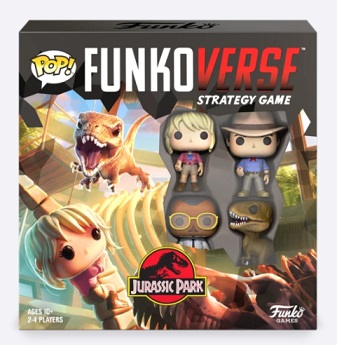 | Funkoverese Strategy Game: Jurassic Park 100 and 101 | IP, kids, combat | Check Price |
| 8. | 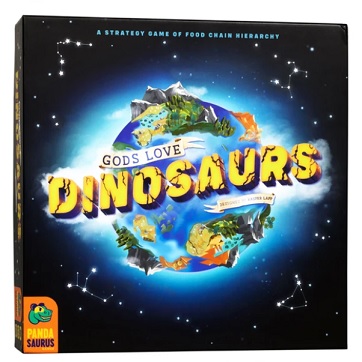 | Gods Love Dinosaurs | tile placement, food chain | Check Price |
| 7. |  | Fossilis | #d board | Check Price |
| 6. | 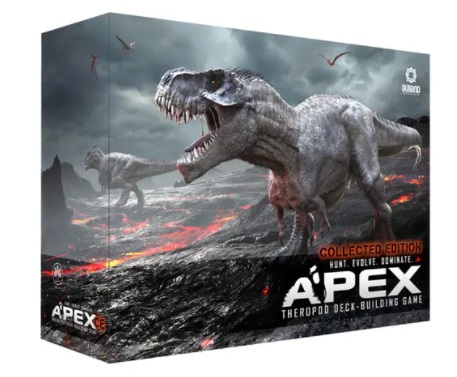 | Apex Theropod | deck-builder | Check Price |
| 5. |  | Dominant Species | strategy | Check Price |
| 4. | 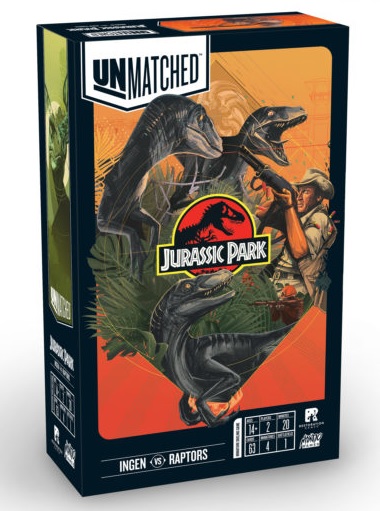 | Unmatched: Jurassic Park – InGen vs Raptors | asymmetric duel | Check Price |
| 3. | 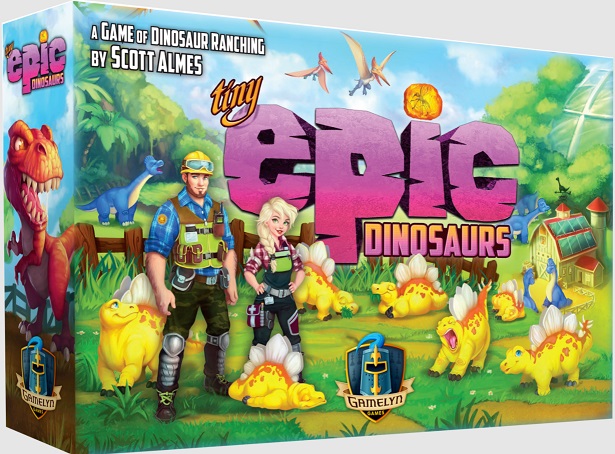 | Tiny Epic Dinosaurs | dino rancher | Check Price |
| 2. | 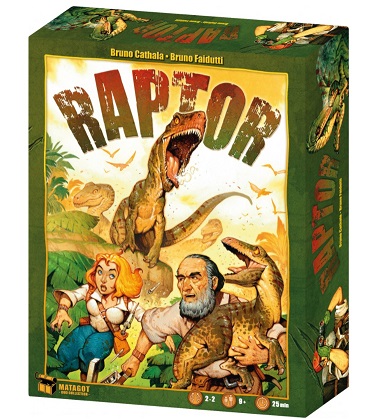 | Raptor | asymmetric duel | Check Price |
| 1. | 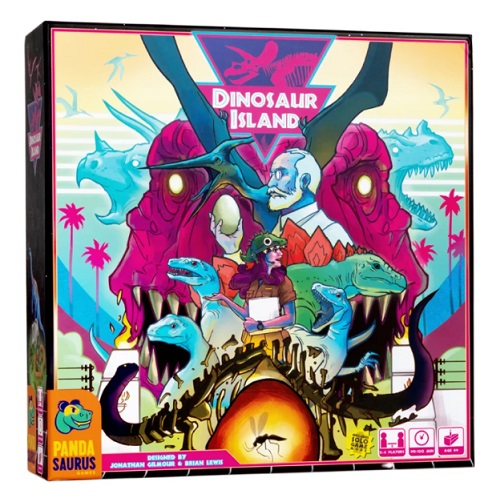 | Dinosaur Island | dino them park | Check Price |
10. Evolution: Climate
Published: 2016
Designers: Dominic Crapuchettes, Dmitry Knorre, Sergey Machin
Playing time: 60 minutes
Players: 2-6
Complexity: medium
A delicate ecosystem
Complex, dynamic ecosystems are a delicate matter. Increase the temperature or supply of food just a bit and the ripple effect will follow, with species adapting and evolving to the new balance. Or becoming extinct if their way of life can no longer be sustained.
Evolution: Climate is a game about managing a number of species (both herbivores and carnivores), growing them in size and population, and adapting their traits to the ever-changing environmental factors. Also, making them better hunters (or better prey).
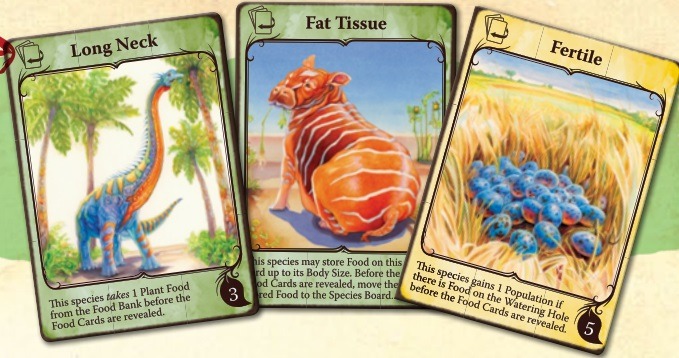
How to play Evolution?
Evolution is a tableau-building card game, where you take care of your species of animals.
Each player begins the round with a certain number of trait cards. He must then use these cards to add food to the food pool, create new species, or enhance his current species. You can enhance your species by adding traits and increasing its size or population.
Horns and herding help with defending against predators. Scavenge, forage, tall neck, and cooperation help with gathering food. And gigantism, burrowing, heavy fur, nocturnal, hibernation, mud wallowing, etc. help you counter environmental threats.
You can also add a carnivore trait to a species. This means it cannot feed on the food pool but must eat other animals (reducing their population) to survive. It can eat your animals or that of other players …
You can even simultaneously sustain a herbivore species with a large population and a carnivore species, that specializes in feeding on that herbivore, making you very independent from the food pool or other players. But it only takes a small climate change or a second predator from another player to tip the balance the wrong way …
Food is not only needed as a means o feeding, but it also counts as victory points. So, the more food you gather and the less food other players gather, the higher your chances of winning are. Species traits also count as victory points at the end of the game, so having a lot of species with a lot of traits is a good thing – as long as you can feed them.
Evolution: Climate is a game of balance between available food, climate, and species adapting to the environment and how to best defend or attack other creatures. In a lush, food-rich climate, you may develop large herbivores with tall necks, living in herds, while other players may develop an intelligent species hunting them in packs. Then, as climate changes to hot, small nocturnal species will thrive, while in cold, fur may help you survive.
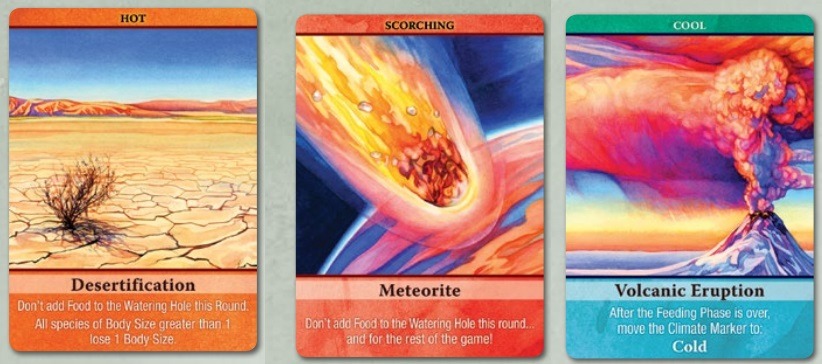
Evolution: Climate Features
- A realistic demonstration of how species adapt and evolve to climate, environment, food, and predators.
- Colorful art.
- Great educational value and is easy to learn.
Buyer’s Guide
Evolution: Climate is not only a great game, but it’s also an excellent learning tool. Only the fact that it’s not just about dinosaurs (they’re just a part of the spectrum) prevents it from being placed higher on our list.
Oceans, an aquatic re-implementation of the game is also worth checking out.
9. Funkoverese Strategy Game: Jurassic Park 100 and 101
Published: 2019 onwards
Designer: Prospero Hall
Playing time: 20-60 minutes
Players: 2-4
Complexity: light-medium
What is Funkoverse?
What if you could have cool characters that you could put into teams and have them perform skirmish battles with easy-to-learn rules? Sounds great, doesn’t it?
Now add really cool miniatures and IPs like Batman, Harry Potter, Jaws, Game of Thrones, DC Comics, and Jurassic Park among others. Oh, and you can mix and match all the maps and characters together as you please.
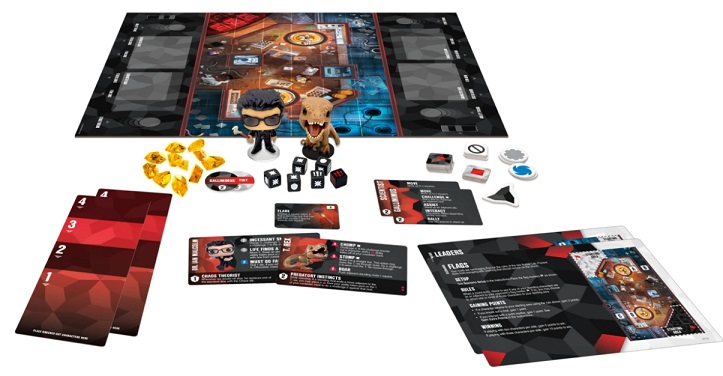
How to play Funkoverse?
Funkovers offers different skirmish scenarios (Flags, Control, Territories, and Leaders) with each having different goals or points threshold.
The game is about fighting and knocking out your opponents. Each turn, you select one of your characters and perform two actions. There are basic actions like moving, supporting allies, challenging enemies, as well as stronger, special actions.
Special actions require ability tokens to perform and use a cooldown track – the strongest the ability, the longer the cooldown.
The challenges are resolved with special dice. While rolling them on the table may be fun, it can also ruin your plans if it’s unfavorable.
Combat mechanics are very accessible, thus making the game family-friendly. Yet, the interesting cooldown track allows for some advanced plays, so there’s a level of strategy involved.
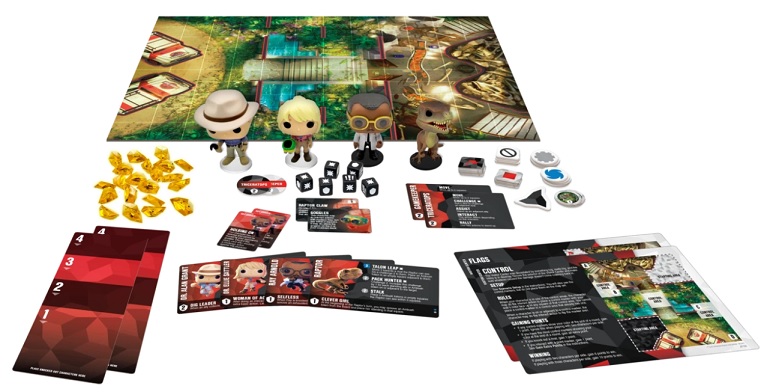
Funkoverse Features
- Unique characters with great-looking miniatures and thematic abilities.
- Squad building (mix-matching various sets) is easy.
- Light, but solid mechanics, although a bit dice-dependant.
Buyer’s Guide
There are 2-character and 4-character sets available. Each is a standalone game that comes with exclusive Funko Pop! Figures, a double-sided board, tokens, cards, an item, and dice.
Jurassic Park 100 comes with Dr. Alan Grant, Dr. Ellie Sattler, Ray Arnold, and Raptor. Visitor Center and Raptor Paddock are available as playable locations.
Jurassic Park 101 features Dr. Ian Malcolm and T. rex, as well as Isla Nublar Lab and T. rex Paddock to play on.
Funkoverse is an excellent skirmish universe for lighter players: families and kids that want to have a fun experience with their favorite movie heroes. There are a lot of choices on how to enter the system and Jurassic Park is as good of a choice as any other.
8. Gods Love Dinosaurs
Published: 2020
Designer: Kasper Lapp
Playing time: 30-45 minutes
Players: 2-4
Complexity: light-medium
What’s it about?
While playing God sounds like fun, it’s an extremely responsible job. One wrong tile and everything collapses. It’s like that in Gods Love Dinosaurs, where you’re building an ecosystem rich and varied enough so that can support dinosaurs. Because we love them.
But dinosaurs have to eat, and their food has to eat too. You’re laying tiles to build homes for Prey, Predators, and Dinosaurs. Only the best-built biome will result in many many dinosaur eggs.
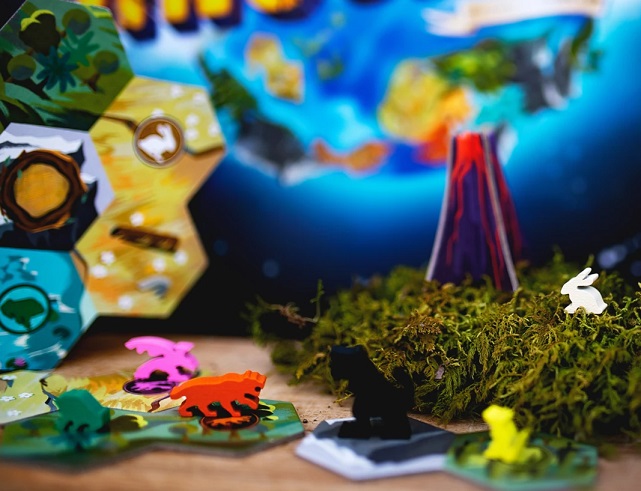
How to play Gods Love Dinosaurs?
You start the game with a starter tile, which holds one prey animal and one dinosaur. Players will then draw new tiles from the central board, growing different habitats and adding new animeeples, when such an icon is present on a habitat.
There aren’t many restrictions on how to place the tiles, but you’ll want to place the same types of habitat together so that the animals have a place to breed.
There are three types of prey (frogs, rabbits, and rats), two types of predators (tigers and eagles), and one type of dinosaur, the king of the food chain.
Taking a tile may also trigger a breeding phase for each of these animals. While prey simply doubles in numbers (providing you have a habitat for them), things get more interesting with larger species.
They have a certain amount of movement and it’s up to you to decide which way they will move and what they will eat. Predators must eat prey to breed, and dinosaurs eat predators if they want to lay precious eggs (points).
While the mechanics are simple, there are o lot of things to consider and you need a pretty solid plan from the beginning. How to place tiles so that prey has room to grow? How will you move predators to feed on prey, but without completely wiping it out? Are your foundations sound enough to support an all-eating dinosaur?
When the food chain works it unravels elegantly, but a shortage of one thing can mean your dinosaur egg engine won’t run at full steam. It can be the difference between thriving and extinction.
Gods Love Dinosaurs Features
- Simple tile-laying board game with sensitive ecosystem-building.
- Colorful artwork and charming animal meeples.
Buyer’s Guide
Gods Love Dinosaurs is an excellent tile-laying game, but it does not stop at that. Although it’s easy to learn, it requires careful planning and analysis.
If you’re looking for a tile-laying board game, but the likes of Carcassonne are too light for you, Gods Love Dinosaurs is a fine choice.
7. Fossilis
Published: 2020
Designer: David Alberto Diaz
Playing time: 45-60 minutes
Players: 1-5
Complexity: light-medium
What’s Fossilis about?
If you were (like me) a kid in the 90’s, you remember the massive dinomania. Dinosaurs were everywhere, Jurassic Park was the best thing ever, and even Ross from Friends was cool. No wonder many of us wanted to become paleontologists.
Our chance is finally here some 25 years later. In Fossilis, players compete against each other at bone-digging and compiling them into dinosaur skeletons.
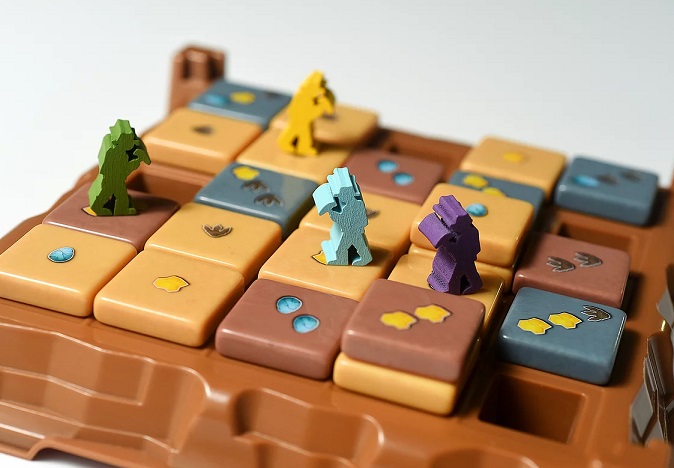
How to play Fossilis?
The first thing you notice is the beautiful 3D central board, with many tiles and spaces for bones underneath. The production quality is quite high – this is no cheap plastic, and having the game on the table will certainly catch looks.
The gameplay is a mix of spending your action points to move your paleontologist on the board, and dig and excavate bones. There’s an element of set collection, as you try to complete skeletons with your precious bones.
There are many dinosaurs to choose from, all with informative and beautifully painted cards, giving you a chance to learn a thing or two along the way. You often have to decide which one to go for, as you can only build one skeleton at a time. Dinosaurs that score more points also take more bones to complete.
The bones are randomly hidden underneath the tiles (the whole board is shaken before the start), so the element of suspense (and luck) is always present. You also have to keep an eye on plaster, which is used to protect the bones as you excavate them, and other paleontologists. They can make your life miserable by moving tiles in your way, competing for your bones, or even knocking you off the board.
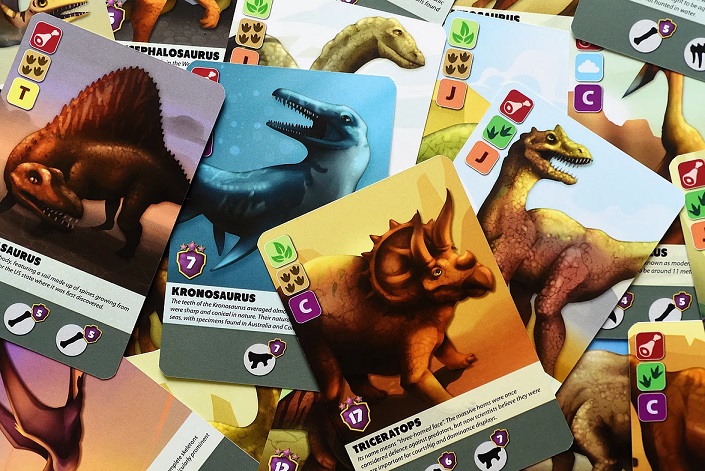
Fossilis Features
- Spectacular (and functional) 3D board.
- Innovative theme.
- Finding bones is exciting.
Buyer’s Guide
Fossilis is an excellent family-friendly game. Kids will absolutely love the 3D board and the search for bones. If you always wanted to be a paleontologist, but life turned out differently, this is your second chance.
It’s also great as a tool to get your kids interested in dinosaurs (or if they already love them). On the other hand, there isn’t much strategy and an element of luck is present, so hardcore gamers will lose interest fast.
6. Apex Theropod Deck-Building Game
Published: 2015, 2020
Designer: Herschel Hoffmeyer
Playing time: 45 minutes
Players: 1-6, best-played solo
Complexity: medium
What’s it about?
Each hunting dinosaur’s dreams are to be at the top of the food chain, to be the apex predator.
You select your species of dinosaur, and by hunting and careful evolution (deck-building), you will aim to replace (beat in combat) the current Apex Theropod.
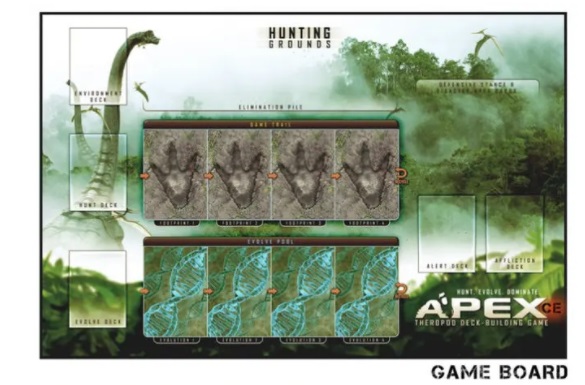
How to play Apex Theropod?
Each species comes with a starter deck. The drill is as usual: you add new cards to this deck, hunt other species, and evolve to become powerful enough to take down the boss dinosaur (or other players, if you don’t play solo – although consider this a predominantly solo game).
What makes Apex Theropod special? Why would you choose it over any other deck-builder, especially over the Legendary series, from which it draws massively?
The game is extremely thematic. Starting with beautiful illustrations of dinosaurs, traits, and events, the gameplay itself continues this trend. I.e. you can set up ambushes, but if you draw an alert card, the prey becomes alert. It can run away, or a Stegosaurus becomes very defensive.
Prey can harm you by adding wound cards to your deck, there are other predators in the game that can eat your prey, denying you food. Some dinosaurs can even come to your nest and steal your eggs.
Such events create a strong atmosphere and you really feel the theme working hand in hand with game mechanics.
The boss fights (against popular predator dinosaurs: T-Rex and co.) are a true test of your deck. Dealing and taking damage can take a while, so there’s a sense of tension and epicness.
The boss fight might show up early, but you have a chance to postpone it if you don’t feel strong enough. But only to a degree, because the whole game is on a timer – asteroid impact is imminent. So you better become The Predator before you are history.
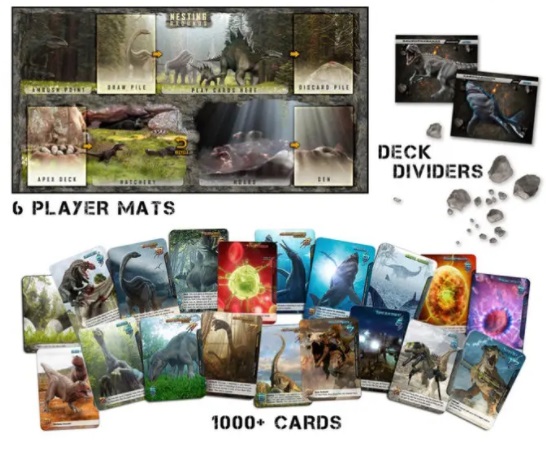
Apex Theropod Features
- Best dinosaur deck-builder.
- Very strong integration of theme into game mechanics.
- Hard to get for a reasonable price or away from Kickstarter.
Buyer’s Guide
There are 8 expansion decks available, but they’ve been part of the 2020 Kickstarter campaign (APEX Theropod Deck-Building Game: Collected Edition), which has everything included – a total of 1040 cards! The base game has 525 cards. If you can, buy the most expansive version possible, as the extra cards really help with variability.
5. Dominant Species
Published: 2010
Designer: Chad Jensen
Playing time: 120-240 minutes
Players: 3-6
Complexity: medium-heavy
What is Dominant Species about?
First, a confession. Dominant Species is not about dinosaurs – that’s why it’s only on P5. But it’s an excellent game about prehistoric animals and I think this list wouldn’t be complete without it.
The year is 90,000 BC and an ice age is approaching. Each player will control one of six animal classes: mammal, reptile, bird, amphibian, arachnid, or insect.
Which animals will prove dominant in the changing climate conditions?
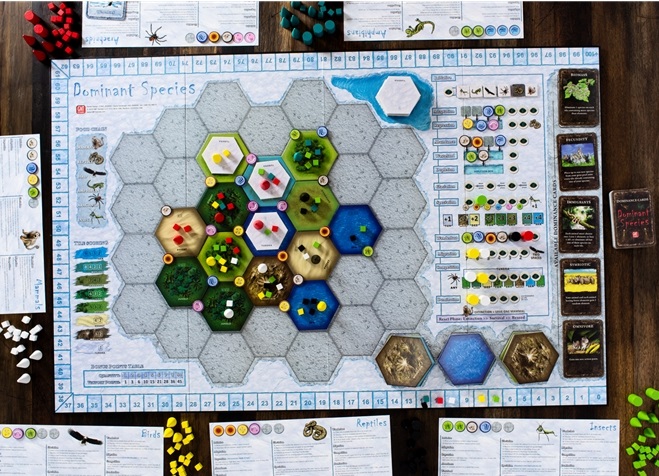
How to play?
Dominant Species is an area control game played on a hexagonal map. There’s an element of worker placement and wargame included. The mechanics are quite complex, but for a group of board game enthusiasts, this will be a 3 hour of pure strategic pleasure.
The game starts in a balanced state, but through placement, expansion, migration, adaptation, and competition, some players and species will come out on top.
There are various terrains (Desert, Forest, Jungle, and similar – eventually a cold Tundra will prevail) and environmental factors (sun, seeds, water, etc.).
Some species will thrive in a certain biome, while another may be deadly to them. The species also come with traits and special abilities. Birds, for example, can move 2 spaces instead of one.
As you can see, there are a lot of factors to consider, including other players. You have to plan ahead and adapt at all times. There are strong euro mechanisms behind it and almost no luck. So it really is the survival of the fittest.
As it’s usual with the genre, politics also plays a role. Should you be too good and run away within the scoring, the others can set aside their differences and gang up on you.
The game ends when the ice age finally starts. The most Dominant Species is determined by having accumulated the most victory points during the game.
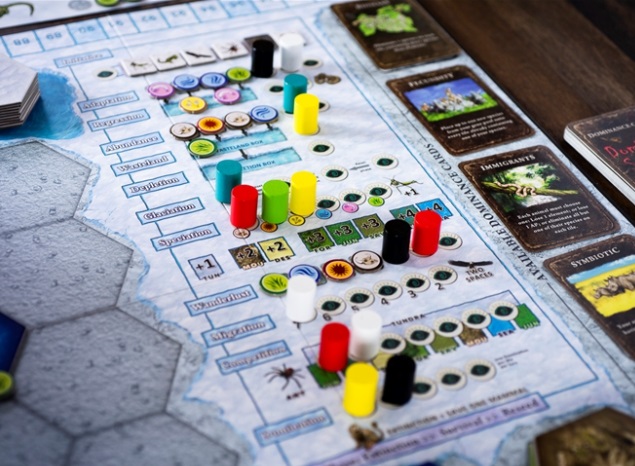
Dominant Species Features
- Tactical domination game with strong underlying eurogame mechanisms.
- Complex (but intuitive rules) create a rewarding and memorable experience.
- Asymmetric factions in an interesting pre-ice-age setting.
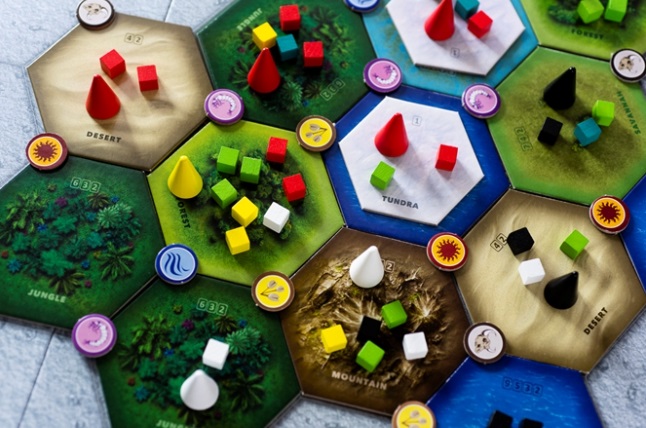
Buyer’s Guide
While it first looks like a wargame game, Dominant Species is much more than just about combat: a deep worker-placement eurogame with a strong conflict note.
If you’re a group of heavier board gamers, you’ll enjoy the tactical freedom it offers. It plays well from 3-6 players, but a full 6-player game might drag on a bit.
4. Unmatched: Jurassic Park – InGen vs Raptors
Published: 2020
Designers: Rob Daviau, Justin D. Jacobson
Playing time: 20-40 minutes
Players: 2 only
Complexity. light-medium
What’s it about?
A re-implementation of Star Wars Epic Duels, Unmatched is an asymmetrical miniature fighting game for two players. There are several IPs available, with Jurassic Park among the most prominent.
The heroes are represented by miniatures and unique decks, that are inspired by their thematic background. The InGen vs Raptors features three raptor miniatures against Robert Muldoon from the Jurassic Park movie.
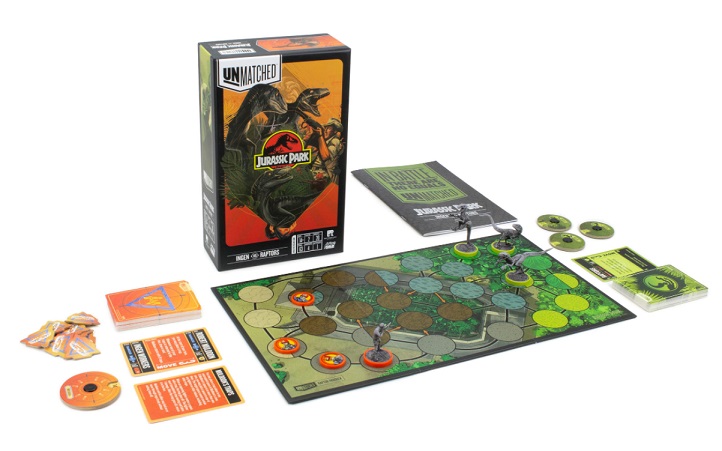
How to play Unmatched?
Unmatched is played on a one-sided board, that allows several paths of movement, one-way-streets, choke points, and ambush locations. The map (raptor pen and surroundings) is small, so the match is action-packed all the way through, although it could as well be double-sided, just to increase the replay value of the game.
The sides are highly asymmetrical, with the raptors’ deck relying on their numbers and melee power, and ambushing. Muldoon revolves more around ranged firepower, traps, and sidekick tokens.
Tactical movement and no-luck combat resolvent (simply comparing attack and defense cards) create a unique play experience that rewards positioning and timing.
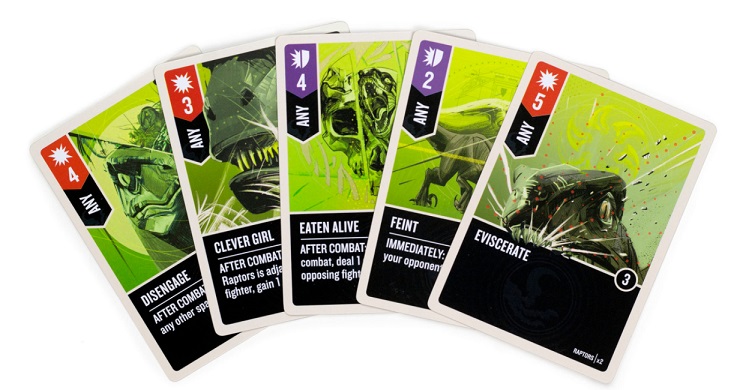
Unmatched: Jurassic Park – InGen vs Raptors
- A top-notch theme, art, and components.
- Clever asymmetrical tactical skirmish.
- The board is only one-sided.
Buyer’s Guide
Unmatched: Jurassic Park – InGen vs Raptors is the second-best asymmetrical skirmish game on our list. It’s slightly lighter than Raptor (see below), but it oozes a licensed theme. If the board were double-sided, their positions would be switched.
If you’re a fan of the Jurassic Park movie and like a quick tactical duel, you’ll love it.
3. Tiny Epic Dinosaurs
Published: 2020
Designer: Scott Almes
Playing time: 30-60 minutes
Players: 1-4
Complexity: medium
What’s it about?
Tiny Epic Dinosaurs is set in an alternate reality, where dinosaurs have been brought back to life and are bred on farms, like cows.
You are a rancher, breeding various species of dinosaurs and selling them through lucrative contracts to the highest bidder.
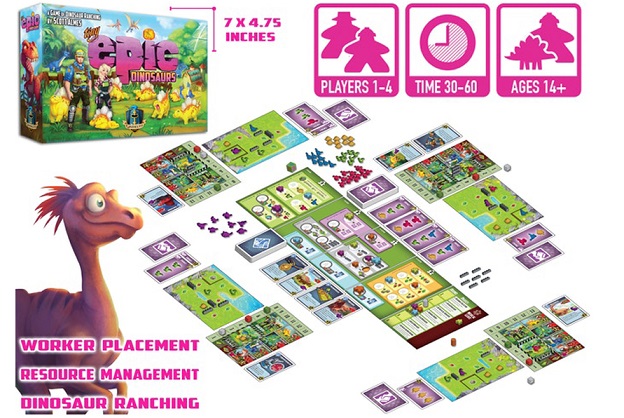
How to play Tiny Epic Dinosaurs?
If you played a worker-placement game before, you’ll be right at home. You place workers to gain resources, research technologies, build enclosings, place dinomeeples, and so on.
Competition for worker slots in Tiny Epic Dinosaurs is pretty high, so having a first-player marker is very beneficial. You can still use an occupied slot though, but it can get expensive. You just have to place one more worker there.
Dinosaurs on your ranch must be fed or they will escape. In this case, you not only lose a hungry dino, but it can also eat another dinosaur if it’s a carnivore. You better fix that fence until the next round …
Having a matching pair of dinosaurs (there are four basic species: Stegosaurus, Brachiosaurus, Velociraptor, and Allosaurus) results in breeding. You’re rewarded with a new dinosaur, providing you have a space for it.
But what’s the point of doing all that, you may ask? See, you’re no dino lover – you’re just a breeder. Dinosaurs will be leaving your ranch all the time as you complete contracts that give out tasty victory points. You can guess the victory conditions, can’t you?
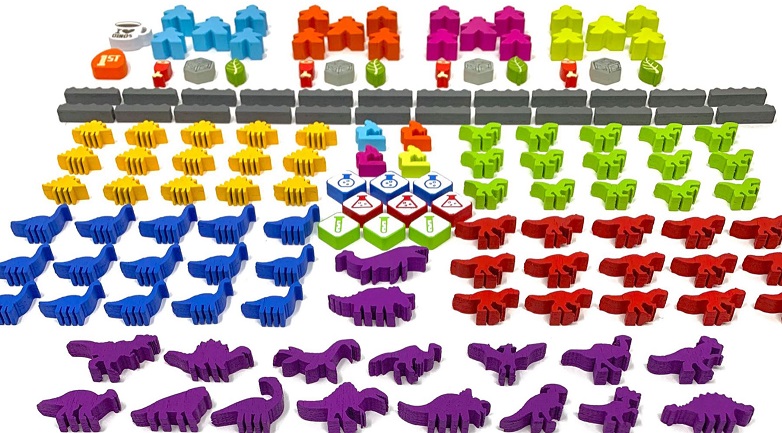
Tiny Epic Dinosaurs Features
- A good medium-weight worker placement eurogame with a dino theme.
- Colorful art and dinoimeeples (although they are a bit tiny).
- Challenging puzzle, especially various solo modes.
Buyer’s Guide
Tiny Epic Dinosaurs is another hit in the Tiny Epic series. It borrows a lot from other games and combines it into an enjoyable strategic experience.
If you love the series, worker-placement mechanics, or the dinosaurs theme, you will definitely like Tiny Epic Dinosaurs.
2. Raptor
Published in 2015
Designers: Bruno Cathala, Bruno Faidutti
Playing time: 30 minutes
Players: 2 players only
Complexity: light-medium
What’s Raptor about?
A group of scientists must work together to catch mama raptor and her babies. The game is for 2 players only, with each playing one side in this asymmetrical cat-and-mouse game.
One side tries to tranquilize and catch dinosaurs, while the other must escape or eat enough scientists.
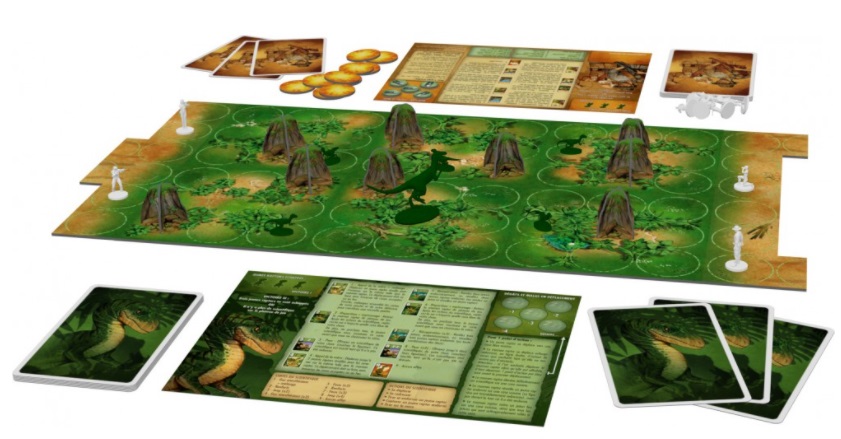
How to play Raptor?
Raptor features a card-driven action system, consisting of both standard and special actions. You can move (obviously), perform more aggressive actions like eating scientists, tranquilizing the momma raptor or a baby, or even set fire to parts of the map to limit movement.
There are plenty of possibilities and they are all very thematic. Scientists must cooperate and use their minds and tools, while the raptor will try to protect her babies.
Each side has a deck of 9 cards (numbered 1-9)and you have a choice of 3 each turn. You select one and both players reveal it simultaneously. The lower number gets to perform a special action, while the higher one does a number of normal actions. This number of actions is defined as a difference between numbers on the cards.
Played-out cards are displayed in front of the players and are always visible. This introduces a layer of card-counting and prediction – what does he have left in his hand?
The sides are balanced nicely (although the scientists are slightly easier to play). Card drawing and a modular map offer a lot of variability.
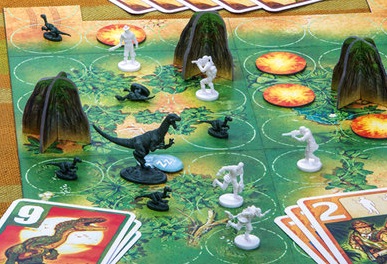
Raptor Features
- Truly an asymmetrical 2-player duel.
- Very thematic with cool miniatures.
- Simultaneous card-play.
Buyer’s Guide
The 2015 Raptor holds up strongly to this day. Despite its relative simplicity, it offers a deep strategic play, albeit it depends on the cards. The theme is very strong and it works with the mechanics perfectly.
If you’re looking for a 2 player game with two sides that require a very different approach, look no further.
1. Dinosaur Island
Published: 2017
Designers: Jonathan Gilmour, Brian Lewis
Playing time: 90-120 minutes
Players: 1-4
Complexity: medium
What’s Dinosaur Island about?
If you were waiting for a game where you can build and manage a dinosaur theme park from the ’90s, here it is. Dinosaur Island is Jurassic Park in everything but the license.
Collect, research, and combine DNA. Place dinosaurs to increase the excitement of your park and attract visitors. But don’t forget about security – eaten visitors mean negative victory points!
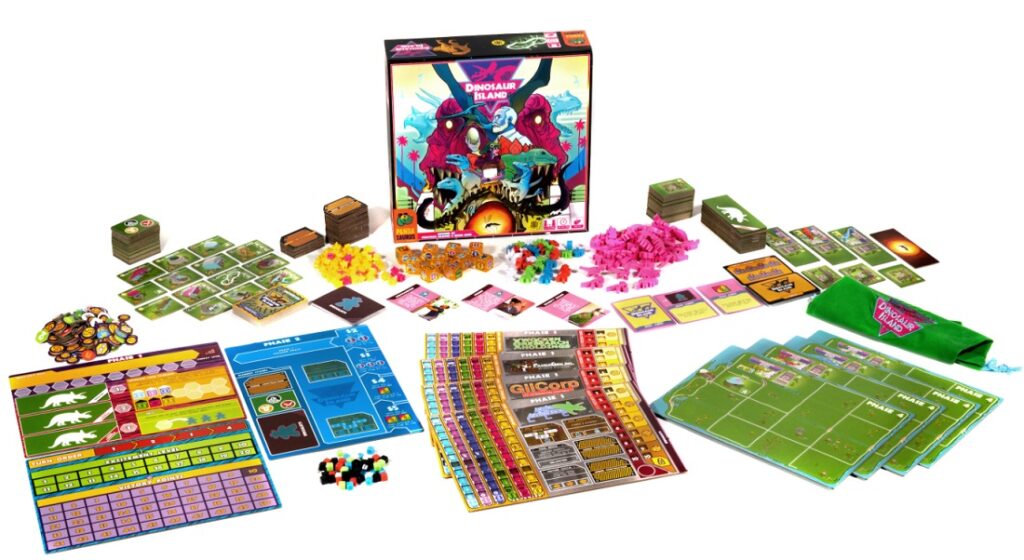
How to play?
Dinosaur Island is a eurogame, using a combination of worker placement, tile placement, set collection, and dice rolling.
The art and style reek of the ’90s: very flashy and colorful, almost kitschy. The components are very good, especially the dual-layered player boards.
Each round goes through a series of phases:
- In the Research phase dice are rolled for the DNA pool and players can assign scientists to acquire it.
- The market phase allows players to buy lab upgrades, build attractions, or hire specialists.
- In the Worker phase, players assign workers in their labs, performing tasks like making advanced DNA, creating dinosaurs, increasing security, collecting money, etc.
- The Park phase is the part where you draw the number of visitors equal to your excitement level from the bag. But beware, among paying customers are hooligans! They don’t pay an entrance fee and are nothing but a pest for your park.
How you spend your resources during these phases is very important, since most of the actions are optional. You need a solid plan on what to focus on. And a bit of luck, especially with DNA rolls and visitor draws.
The number of rounds is not a fixed number. The game ends when only one objective card is left, which means the length of the game can be easily adjusted with the number of objective cards.
Other than the competition for the DNA, there’s not much player interaction, which makes Dinosaur Island very scalable. It plays smoothly with all player numbers and it even includes a very good solo mode.
Your main victory point source is your visitors. Keep your excitement levels high with attractive dinosaurs and your security level high enough so that not too many of them get eaten (they know what they’re getting into!). And try not to draw too many hooligans!

Dinosaur Island Features
- Ultimate dinosaur theme park game.
- Colorful art and appealing theme.
- Plays smoothly, despite utilizing several game mechanics.
- Offers a lot of variabilities.
- Requires planning, but some luck is involved.
Buyer’s Guide
Dinosaur Island: Totally Liquid is an expansion that adds components for the 5th player, water dinosaurs, and a few other components. It’s nice to have, but not essential.
Duelosaur Island is a simplified two-player game. Since the base game plays great with two players anyway and it’s not very complex, this makes Duelosaur Island redundant.
Dinosaur World and Dinosaur Island: Rawr ‘n Write are the latest titles. The first one promises a revised and upgraded version of Dinosaur Island, while the latter is built around an increasingly popular mechanic, roll-and-write.

No mention of Dodo’s riding Dino’s?
Must be because it’s still in (KS) production.
There are many dinosaur board games that did not make the cut for one reason or the other. Draftosaurus, Dinogenics, Bios: megafauna 2nd ed, Triassic Terror, Jurassic Parts, Dino Dude Ranch and Extincion among others.
Perhaps the top 10 list will change in the future. 🙂